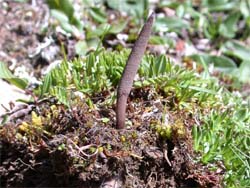

The Chinese caterpillar fungus
Following an investigation of the aweto (or Chinese caterpillar fungus) resources from May to July 2007 on the Tibetan Plateau, the central producing area of this precious ingredient for the traditional Chinese medicine (TCM), researchers from the CAS Xishuangbanna Tropical Botanical Garden (XTBG) conducted a further survey on the aweto's marginal habitats from May to July 2008.
Funded by CAS, this survey covered the populations on the south and the north verges of its geographical range , including those on the southeastern skirts of the Tibetan Plateau in Yunnan Province and those scattering in the mountainous areas on the north edge of the Plateau in Gansu and Qinghai provinces, in a bid to reveal the impact of human herborizing on the local ecological environment.
The aweto is actually the combination of two species from two different biological kingdoms, consisting of the fruiting body of a fungus called Cordyceps sinensis and the corpse of a caterpillar named Hepialus spp.. This is just the peculiar outcome of a common phenomenon created by magical Nature, parasitism.
In the winter, the fungus invades in the body of the caterpillar, and relies on the nutrition from its host to grow and multiply itself. While it grows, the fungus extends its mycelium everywhere within the body of the poor caterpillar, until the former totally replaces the tissues of the latter. By late spring or early summer, the fruiting body of the fungus, or the stroma resulting from this robbery of nutrition sprouts from the head of the host caterpillar, in a cylindrical shape.
Because of this special process of growth, the aweto is well known as "summer grass winter worm" in China. It has a long history as a healing fungus in TCM, being used as tonic for feeble people.
Strong demands for this precious medicinal material, however, have pulled lots of pickers to its habitats. Their herborization ruins the surface soil and vegetation on the frigid Plateau, posing great pressure on the local wildlife ecologies and pushing this fungus to the verge of extinction. In this context, the survey was launched to evaluate the conditions of the aweto resources and identify the impact of the human intervention on the fragile ecological balance in its producing areas. Combining the data from last year's investigation, so far the analysis of this survey has initially revealed some fundamental facts about the distribution of aweto resources, and meanwhile alerted some dangerous trends.
On the Tibetan Plateau, the aweto is revealed to have a distribution stretching northward from the Mt. Cangshan in Dali (Tali) Prefecture in Yunnan Province, or more exactly at E99°34'/N25°45', to the Qilian Mountains to the south of the Gansu Corridor (Kansu Corridor), exactly at E102°90'/N38°49'. Beyond this range, no aweto is found in the survey.
The distribution of the aweto on the Plateau has a noticeable heartland, which covers the areas including parts of the Nakqu, Chamdo and Nyingchi prefectures in Tibet Autonomous Region, Yushu Prefecture in Qinghai Province, Tibetan Qiang Autonomous Prefecture of Aba (Ngawa) and Tibetan Autonomous Prefecture of Garze in Sichuan Province, Diqing Prefecture in Yunnan Province and, part of the Gannan Prefecture in Gansu Province. This central zone produces about 70% of the national aweto yield. On the other hand, aweto from the central zone has the best quality and the biggest sizes; the farther the producing area is from the central zone, the poorer the quality of the aweto resource and the smaller the size.
A shocking trend revealed by the survey is, in the central zone, the prime altitude around which the aweto grows has risen by 200 to 500 meters compared to 20 years ago. At present the prime altitude ranges between 4,400 to 4,600 meters above sea level, while it used to be between 3,900 to 4,400 meters only two decades ago. What also deserves concern is, the prime altitude range has narrowed down significantly. In the marginal areas, things are also less than encouraging. Although the prime altitude sees little change there, the yield goes down and the quality worsens: The aweto differentiates a lot in size, shape and color from that in the central zone, showing evident signs of polarization between populations.
According to the scientists with XTBG, the worrying trends unveiled in the investigation might be related to global warming and predatory herborization, though the detailed results from further analyses are still under way.

86-10-68597521 (day)
86-10-68597289 (night)

52 Sanlihe Rd., Xicheng District,
Beijing, China (100864)

